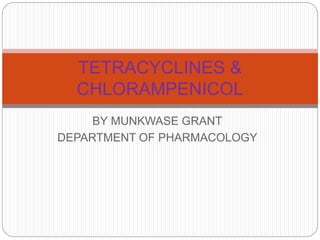
Tetracyclines and chloramphenicol ppt
- 1. BY MUNKWASE GRANT DEPARTMENT OF PHARMACOLOGY TETRACYCLINES & CHLORAMPENICOL
- 2. Introduction One of the mechanisms of action for antimicrobial agents is inhibition of protein synthesis Protein synthesis is inhibited at the step of translation in the ribosomes Protein synthesis inhibitors include aminogycosides, Tetracyclines, Macrolides, Clindamycin, oxazolidinones,Chloramphenicol, & Streptogramins Protein synthesis inhibitors are mainly bacteriostatic except aminogycosides
- 6. TETRACYCLINES Are classified in two ways 1. According to source Natural Semi synthetic 2. According to duration of action Short acting(half life is 6-8hrs) Intermediate(halflife is 12hrs) Long acting(halflife is >16hrs)
- 7. Classification by source Natural Chlortetracycline Oxytetracycline Demeclocycline Semi synthetic Doxycycline Tetracycline Minocycline Lymecycline Methacycline Rolitetracycline Tigecycline
- 8. Classification by duration of action Short acting Intermediate acting Long acting •Tetracycline •Oxytetracycline •chlortetracycline •Demeclocycline •Methacycline •Doxycycline •Minocycline •Tigecycline
- 9. Mechanism of action Inhibits protein synthesis Binds reversibly to the 30s subunit of the ribosome inhibit amino acid incorporation by blocking the attachment of aminoacyl tRNA to the “A”(acceptor) site Bacteriostatic
- 10. Pharmacokinetics Free tetracyclines are crystalline amphoteric substances of low solubility. They are available as hydrochlorides, which are more soluble Variable absorption following oral administration 30% for chlortetracycline 60-70% for tetracycline, Oxytetracycline, Methacycline 95-100% for Doxycycline and Minocycline Tigecycline is poorly absorbed orally & must be administered IV.
- 11. Pharmacokinetics Absorption occurs mainly in the upper small intestine Absorption is impaired by; food (except Doxycycline and Minocycline) divalent cations (Ca2+, Mg2+, Fe2+) or Al3+ dairy products and antacids alkaline pH Tetracyclines are 40-80% bound by serum proteins
- 12. Pharmacokinetics Tetracyclines are distributed widely to tissues and body fluids except for cerebrospinal fluid Tetracyclines cross the placenta to reach the fetus and are also excreted in milk Tetracyclines are excreted mainly in bile and urine but also in feaces to a small extent Doxycycline and Tigecycline eliminated by nonrenal mechanisms
- 13. Spectrum of activity: Tetracyclines are broad-spectrum antibiotics. They are active against the following microorganisms: gram-positive and gram-negative bacteria Spirochetes mycoplasmas rickettsiae
- 14. Spectrum of activity Mycoplasma pneumoniae Chlamydia trachomatis Borrelia recurrentis. Yersinia pestis Vibrio cholerae Campylobacter fetus Brucella species Streptococcus pneumoniee. Neisserie gonorrhoeae Helicobacter pylori
- 15. Resistance to tetracyclines Impaired influx or increased efflux by an active transport protein pump Ribosomal protection Enzymatic inactivation. Most organisms resistant to tetracyclines are susceptible to Tigecycline(not a substrate for efflux pump) except proteus and pseudomonas aeruginosa
- 16. Clinical uses of tetracyclines Drug of choice in infections with Mycoplasma pneumoniae, Chlamydia, rickettsiae, and some spirochetes Various gram-positive and gram-negative bacterial infections Used in combination regimens to treat gastric and duodenal ulcer disease caused by Helicobacter pylori. Indicated for plague, tularemia, and brucellosis Treatment of acne Treatment of protozoal infections including p.falciparum
- 17. Side effects of tetracyclines GIT irritation ( reduced by coadministration of food) Photosensitivity Hepatotoxicity and renal toxicity Permanent brown discoloration of teeth( do not use in children less than 8years) Depress bone growth in infants Hypersensitivity reactions(e.g angioedema,anaphylaxis,urticaria etc)
- 18. Major drug interaction of tetracyclines:: Antacids containing aluminum, calcium, or magnesium, and iron-containing preparations Impair the Absorption of tetracyclines Anticoagulant therapy Tetracyclines have been shown to depress plasma prothrombin activity, patients who are on anticoagulant therapy may require downward adjustment of their anticoagulant dosage. Bactericidal drugs Interfere with the bactericidal action of penicillin, it is advisable to avoid giving tetracycline-class drugs in conjunction with penicillin.
- 19. CHLORAMPHENICOL
- 20. Mechanism of action Inhibits protein synthesis Binds reversibly to 50 s subunit of ribosome Block transpeptidation by inhibiting peptidyl transferase Broad spectrum bacteriostatic antimicrobial Antibacterial activity H. Influenza S. typhi N. Meningitidis E. coli S. Pneumoniae V.cholera Rickettsiae Anaerobes- clostridium & B. fragilis CHLORAMPHENICOL
- 21. Pharmacokinetics Crystaline chloramphenicol is neutral, stable, soluble in alcohol but poorly soluble in water Chloramphenicol succinate(prodrug) given parenteraly is highly water-soluble Rapidly & completely absorbed from GIT About 50 % protein bound Metabolized mainly by liver through glucuronide conjugation but may also under go reduction Well distributed, including CNS and CSF Excreted largely in urine. To a small extent in bile and feaces
- 22. Resistance Production of chloramphenicol acetyltransferase that inactivates the drug(major) Ribosomal mutation Decreased permeability
- 23. Clinical uses Use limited because of potential toxicities 1. Typhoid fever- s. typhi ( quinolones are preffered) 2. Meningitis – H.influenzae,N.meningitidis,S.pneumoniae ( Ceftriaxone is preffered ) 3. Anaerobic infections- B. fragilis (Metronidazole is the drug of choice) 4. Rickettsial infections – Doxycycline is preffered 5. Bacterial conjunctivitis ( topical )
- 24. Side effects & interactions 1. Hypersensitivity- low incidence 2. Dose related and reversible bone marrow suppression 3. A plastic anaemia ( fatal and irreversible) 4. Grey baby syndrome 5. Suprainfections Interaction with other drugs Inhibits liver microsomal enzymes Phenytoin Tolbutamide Chlorpropamide Anticoagulants Chloramphenicol can antagonize bactericidal drugs
- 25. THANK YOU END